


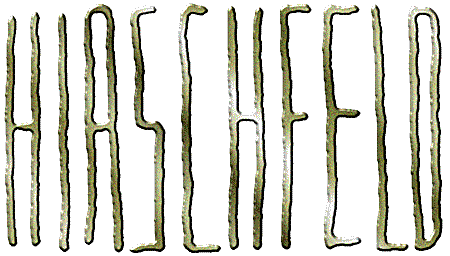
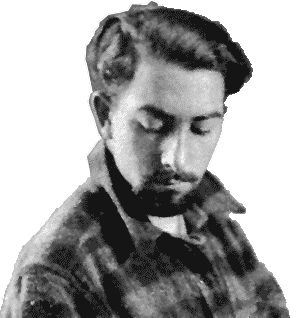
 Al
Hirschfeld is a child prodigy who grew old but never up. His view
of the world around him, particularly the American theater, is
as fresh and unique and joyous as ever. He was born in 1903 and
the twentieth century was full of opportunities for an ambitious
young man. As a teenager, he lived in New York City and studied
art. After an early but short career with Samuel Goldwyn Studios
(where he got his first art assignments doing ads) he moved over
to Selznick Pictures and by 1921, at the ripe old age of 17, he
was their art director. A short stint running his own art studio
ended up badly when Selznick went bankrupt. A job with Warner
Brothers allowed Hirschfeld to pay off his employees and, as a
reward, his uncle bought him a ticket to Paris and gave him $500.
Al
Hirschfeld is a child prodigy who grew old but never up. His view
of the world around him, particularly the American theater, is
as fresh and unique and joyous as ever. He was born in 1903 and
the twentieth century was full of opportunities for an ambitious
young man. As a teenager, he lived in New York City and studied
art. After an early but short career with Samuel Goldwyn Studios
(where he got his first art assignments doing ads) he moved over
to Selznick Pictures and by 1921, at the ripe old age of 17, he
was their art director. A short stint running his own art studio
ended up badly when Selznick went bankrupt. A job with Warner
Brothers allowed Hirschfeld to pay off his employees and, as a
reward, his uncle bought him a ticket to Paris and gave him $500.
Six months in 1925 were spent in Europe and he returned to New York primed for a career as a painter. But on December 26, 1926 the sketch he had done of actor Sacha Guitry (right) was published in the NY Herald Tribune. Within two years his theatrical drawings were appearing in five different New York newspapers, including the Times, for whom he still works today.
A trip to Russia on his honeymoon resulted in his submitting a host of material for a proposed book to a publisher who promptly lost it all. The work was never recovered and the book never came to be. A year-long trip soon after was financed when a globe-trotting Charlie Chaplin stopped in Bali and purchased some of Hirschfeld's watercolors. Hirschfeld returned to the theater sketching business—but just to make enough money to finance another trip to Paris. Paintings, lithographs, political cartoons all began to make room for his love of the line.
|
Art & Industry 1931 lithograph as seen in Hirschfeld On Line |
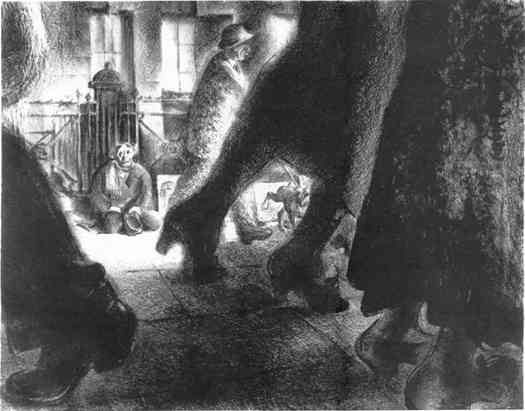
|
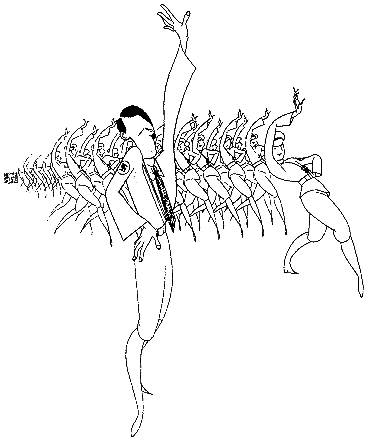 Politico-Erotica, 1933 also from Hirschfeld On Line This drawing originally appeared in a satirical magazine that Hirschfeld published with fellow artist, Alexander King. Not only is it "an early attack on Hitler," as Hirschfeld notes in the book, but it is also very precognitive of a certain "Springtime for Hitler" as seen in Mel Brooks' first film, the 1968 classic, The Producers. |
|
 During
the Thirties, as theater in America grew and matured, Hirschfeld's
job was to capture the essence of each play prior to opening night.
He would attend the out-of-town performances and present his drawing
to the citizens of New York the Sunday preceding the opening.
A new generation of playwrights (Rodgers and Hart, Orson Welles,
Clifford Odets, and William Saroyan to name a few) was expanding
the scope of the theater and the actors and actresses of the day,
like Alfred Lunt and Lynn Fontanne (at right) rose to meet the
challenge. As did Hirschfeld. The record he's made of the plays
and actors, famous and obscure, is unique and priceless. Just
as priceless was his 1932 book, Manhattan Oases, in which
he depicted the bars and bartenders of New York.
During
the Thirties, as theater in America grew and matured, Hirschfeld's
job was to capture the essence of each play prior to opening night.
He would attend the out-of-town performances and present his drawing
to the citizens of New York the Sunday preceding the opening.
A new generation of playwrights (Rodgers and Hart, Orson Welles,
Clifford Odets, and William Saroyan to name a few) was expanding
the scope of the theater and the actors and actresses of the day,
like Alfred Lunt and Lynn Fontanne (at right) rose to meet the
challenge. As did Hirschfeld. The record he's made of the plays
and actors, famous and obscure, is unique and priceless. Just
as priceless was his 1932 book, Manhattan Oases, in which
he depicted the bars and bartenders of New York.
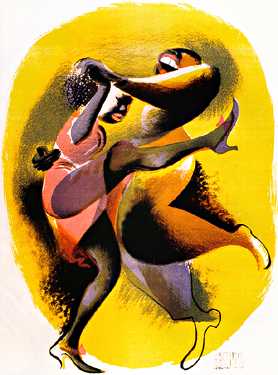 The
Forties saw Tennessee Williams, Oklahoma, St.
Louie Woman, South Pacific and marriage
to Dolly Haas. Hirschfeld also tried his hand at another book.
This one, on and titled Harlem, was published in a limited
edition of 1000 just before Pearl Harbor. Only a few hundred copies
were sold before the publisher went bankrupt and a distracted
America went to war. All were eventually distributed but it is
doubtful if Hirschfeld saw any profit from them. The color lithographic
illustrations, like "Lindy Hop" at left, are still powerful
and he would return to the medium of lithography again and again.
The
Forties saw Tennessee Williams, Oklahoma, St.
Louie Woman, South Pacific and marriage
to Dolly Haas. Hirschfeld also tried his hand at another book.
This one, on and titled Harlem, was published in a limited
edition of 1000 just before Pearl Harbor. Only a few hundred copies
were sold before the publisher went bankrupt and a distracted
America went to war. All were eventually distributed but it is
doubtful if Hirschfeld saw any profit from them. The color lithographic
illustrations, like "Lindy Hop" at left, are still powerful
and he would return to the medium of lithography again and again.
Another momentous Forties event was the birth of the NINAs. His daughter Nina was born in 1945. Hirschfeld drew her name in the background of the theatrical drawing, for the play Are You With It, that he did that day. The flowing lines of the N I N A were occasionally worked into the folds of drapery or strands of hair. (See The Gin Game below.) It became a game he played with his audience. In 1956 he actually appended a numeral after his signature to tell his fans how many NINAs he'd hidden.

 Now,
much has been made of Hirschfeld and line. Rightfully so. Yet,
when you examine his work from the Thirties and Forties, you see
more use of tones and splatters to create texture, and more use
of solid blacks. As the "NINA Game" progresses, these
experiments become less and less frequent. He still experiments
and develops though. His love affair with the line has always
been there, but as the years progress, you see that line simplify
and the actual strokes elongate to where you actually become amazed
at the complexity of that single, simple line. The mastery and
beauty of that flowing trace of ink is regularly and stylistically
contrasted with fine-line textures. I've often wondered how much
of the texturing has been retained in his style simply to hide
"NINA"s and to what extent his style might have evolved
to even simpler, more elegant lines if the NINAs had never been.
Now,
much has been made of Hirschfeld and line. Rightfully so. Yet,
when you examine his work from the Thirties and Forties, you see
more use of tones and splatters to create texture, and more use
of solid blacks. As the "NINA Game" progresses, these
experiments become less and less frequent. He still experiments
and develops though. His love affair with the line has always
been there, but as the years progress, you see that line simplify
and the actual strokes elongate to where you actually become amazed
at the complexity of that single, simple line. The mastery and
beauty of that flowing trace of ink is regularly and stylistically
contrasted with fine-line textures. I've often wondered how much
of the texturing has been retained in his style simply to hide
"NINA"s and to what extent his style might have evolved
to even simpler, more elegant lines if the NINAs had never been.
Take the 1996 drawing of Adolph Ochs, the publisher of The New York Times. First of all, if I can even pick up a pen when I'm 93, I'll count myself fortunate. But secondly, notice the two lines that form his torso and arms and the daring use of white space to delineate the left arm. That's the part that thrills me, much more than his inventiveness at hiding NINAs. I sure hope that he didn't divert too much energy to that aspect of his art.
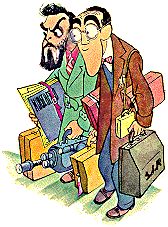 Hirschfeld
met S.J. Perelman in Paris in 1929 and that relationship survived
a collaborative and abortive effort in the early 40's as playwrights.
It was tested further with an eight-month-around-the-world-jaunt
that resulted in the 1948 Westward Ha!, the first of many
books they did together - SJP writing the witty words and AH doing
the pretty pictures. Others included a 1949 collection of Perelman
New Yorker pieces, Listen to the Mockingbird and
the 1950 The Swiss Family Perelman. Hirschfeld also provided
illustrations for the 1986 memoir of SJP, And Did You Once
See Sidney Plain?.
Hirschfeld
met S.J. Perelman in Paris in 1929 and that relationship survived
a collaborative and abortive effort in the early 40's as playwrights.
It was tested further with an eight-month-around-the-world-jaunt
that resulted in the 1948 Westward Ha!, the first of many
books they did together - SJP writing the witty words and AH doing
the pretty pictures. Others included a 1949 collection of Perelman
New Yorker pieces, Listen to the Mockingbird and
the 1950 The Swiss Family Perelman. Hirschfeld also provided
illustrations for the 1986 memoir of SJP, And Did You Once
See Sidney Plain?.
The Fifties and Sixties, there were more and more NINAs and more and more theatrical images. The actual mechanics of his getting the input for those famous drawings is, itself, rather amazing. Considering the fact that theaters are, by nature of their function, rather dark, the process of taking notes and capturing concepts and likenesses is a difficult one. Hirschfeld has managed by scribbling notations into a sketchbook—shorthand images that eventually will be assembled into a finished drawing later. Supposedly these would be meaningless to you and me, but I'm still dying to see the components that make up the parts of his drawings.
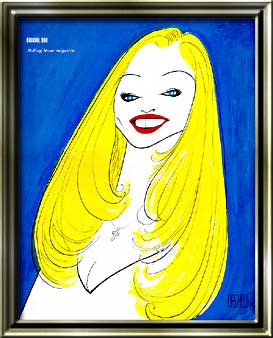 In
1969 he issued a set of ten color lithographs in an edition of
120, and another, of Japanese images, in 1975, in an edition of
250. Samples of these and other color work can be found in Hirschfeld
On Line - a surprisingly difficult book to locate considering
it was published in 1999. He's done TV Guide covers, Time
covers, and, in 1998 (do the math, folks) the image of Madonna
at left for Rolling Stone. He drew all the images for two
1990's U.S. postage stamps series: Comedians and Silent
Film Stars.
In
1969 he issued a set of ten color lithographs in an edition of
120, and another, of Japanese images, in 1975, in an edition of
250. Samples of these and other color work can be found in Hirschfeld
On Line - a surprisingly difficult book to locate considering
it was published in 1999. He's done TV Guide covers, Time
covers, and, in 1998 (do the math, folks) the image of Madonna
at left for Rolling Stone. He drew all the images for two
1990's U.S. postage stamps series: Comedians and Silent
Film Stars.
In 1996, the Academy Award-Nominated film, The Line King was shown on PBS. It's the documentary of Hirschfeld's life and I highly recommend it to any of his fans who missed it. His vitality and energy are astounding. At the time of this writing, he's still going strong approaching his 97th birthday.
The aggregate of his life's work is monumental. He's worked for the New York Times for over 70 years. He's provided not only a record of the American entertainment of the 20th century, but one delineated by his supreme talent. And, nearly as important I think, the record is viewed from a sustained perspective.
I just received word that Mr. Hirschfeld died yesterday, January 20, 2003. I miss him already. To see the entire oeuvre of his work, visit The Margo Feiden Galleries
To see the entire oeuvre of his work, visit The Margo Feiden Galleries (they are Hirschfeld's exclusive representative since 1969)
To learn more about Al Hirschfeld, see:
| Show Business is No Business | Al Hirschfeld, 1951 Simon & Schuster |
| The American Theatre | Al Hirschfeld, 1961 George Braziller, |
| Hirschfeld by Hirschfeld | Al Hirschfeld, 1979 Dodd-Mead |
| Hirschfeld On Line (from which most of the images above are taken) | Al Hirschfeld, 1999 Applause |
| Margo Feiden | of Margo Feiden Galleries (phone conversation April 2002) |
| The Vadeboncoeur Collection of Knowledge | Jim Vadeboncoeur, Jr. 2000 |
|
Illustrations are copyright by Al Hirschfeld
and reproduced by special arrangement with The Margo Feiden Galleries, Ltd, New York. This page written, designed & © 2000 by Jim Vadeboncoeur, Jr. Updated 2002, 2003 & 2011. |
